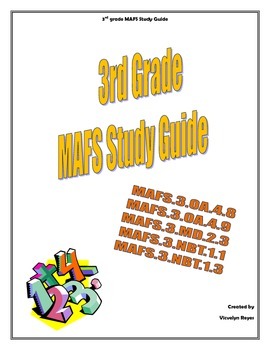3rd Grade MAFS Study Guide/Test Prep
Vicvelyn Reyes
213 Followers
Grade Levels
3rd
Subjects
Resource Type
Standards
CCSS3.MD.B.3
CCSS3.NBT.A.1
CCSS3.NBT.A.3
CCSS3.OA.D.8
CCSS3.OA.D.9
Formats Included
- PDF
Pages
8 pages
Vicvelyn Reyes
213 Followers
Description
3rd grade MAFS Study Guide is a tool to review the Mathematics Florida Standards as a Test Prep. The study guide uses examples from the FSA Test Item Specification. This study guide covers MAFS.3.OA.4.8; MAFS.3.OA.4.9; MAFS.3.MD.2.3; MAFS.3.NBT.1.1; MAFS.3.NBT.1.3. It is a 5 days review that includes problems with multiple choice, multi-response and table response. It uses repetition as an instructional strategy. Students will solve similar problems every day with the goal of mastering these standards after the 5th day.
For more 3rd Grade MAFS Study Guides go to http://www.teacherspayteachers.com/Store/Vicvelyn-Reyes
4th Grade MAFS Study Guides are also available.
Be sure you are following the store to be the first to find out about sales, flash freebies, discounts and great new products. Click "follow me" next to the green star.
For more 3rd Grade MAFS Study Guides go to http://www.teacherspayteachers.com/Store/Vicvelyn-Reyes
4th Grade MAFS Study Guides are also available.
Be sure you are following the store to be the first to find out about sales, flash freebies, discounts and great new products. Click "follow me" next to the green star.
Total Pages
8 pages
Answer Key
Included
Teaching Duration
N/A
Report this resource to TPT
Reported resources will be reviewed by our team. Report this resource to let us know if this resource violates TPT’s content guidelines.
Standards
to see state-specific standards (only available in the US).
CCSS3.MD.B.3
Draw a scaled picture graph and a scaled bar graph to represent a data set with several categories. Solve one- and two-step “how many more” and “how many less” problems using information presented in scaled bar graphs. For example, draw a bar graph in which each square in the bar graph might represent 5 pets.
CCSS3.NBT.A.1
Use place value understanding to round whole numbers to the nearest 10 or 100.
CCSS3.NBT.A.3
Multiply one-digit whole numbers by multiples of 10 in the range 10–90 (e.g., 9 × 80, 5 × 60) using strategies based on place value and properties of operations.
CCSS3.OA.D.8
Solve two-step word problems using the four operations. Represent these problems using equations with a letter standing for the unknown quantity. Assess the reasonableness of answers using mental computation and estimation strategies including rounding.
CCSS3.OA.D.9
Identify arithmetic patterns (including patterns in the addition table or multiplication table), and explain them using properties of operations. For example, observe that 4 times a number is always even, and explain why 4 times a number can be decomposed into two equal addends.





